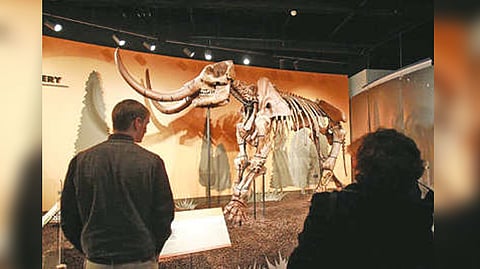

NEW YORK: Over 13,000 years ago, an American mastodon roamed what is today the American Midwest. Year after year, he returned to an area in northeast Indiana — believed to be a mating ground. It was there that he died in battle.
Where the mastodon spent his life and how he died were all recovered by studying chemical signatures recorded in his tusk, scientists reported Monday in the Proceedings of the National Academy of Sciences.
Their techniques offer new insight into one of several ancient elephant relatives that roamed North America before going extinct.
Scientists studied the Buesching mastodon, named for the family farm where it was found in 1998, and now on display at the Indiana State Museum.
Also known as Fred, his tusks, like those of modern elephants, record an animal’s entire life history and enable scientists to glean information from specific days, weeks or years.
Thus, the scientists could specifically sample areas within its tusk from its adolescence and adulthood and determine how its migration changed over time.
This migratory detective work focused on strontium and oxygen isotopes in the tusks.
Joshua Miller, a paleoecologist from the University of Cincinnati and an author of the study, described strontium isotopes as leaving signals all over the landscape.
Strontium isotopes leach from rocks into surrounding soil and water. As plants absorb those nutrients, they incorporate “those isotopic signatures,” he explained. Our hungry mastodon would come along and eat those plants, stamping that geographic fingerprint into his tusks.
Interpreting these geographical references and matching them onto the landscape takes one more step: a map of how strontium isotopes change across terrain.
The authors built upon the work of other scientists, including Brooke E. Crowley, also of Cincinnati and one of the study’s co-authors, who had created such a map.
Oxygen isotopes helped to uncover the seasons in which Fred migrated. Each time it rained, atmospheric isotopes recording the season were incorporated into local bodies of water and ingested when he drank from nearby ponds and streams.
Together with complex statistical modeling, the team was able to determine the movement of this animal.
When he was young, this mastodon stayed relatively local. During his adolescence, however, the researchers found evidence of nutritional stress — something common in male elephants today when they leave their matriarchal herds and start to fend for themselves.
Things drastically changed for this mastodon from his 29th through his 32nd years. Suddenly, he was moving over great distances with signs of repeated injury. But he kept returning to northeast Indiana every year — a location, the authors noted, that he never explored in his adolescent years.
There, in late spring and early summer, he suffered injuries, an important clue that it might have been a mating ground.
Daniel Fisher, a paleontologist at the University of Michigan and also an author of the study, explained that pits on the surface of a mastodon’s tusk are just one trace injuries leave behind. Those injuries leave an internal mark as well.
“The methods that they’re using are part of a broader trend in Quaternary vertebrate paleontology to add a lot more detail to the behavior and the ecology of these animals,” said Chris Widga, a vertebrate paleontologist and head curator at the Gray Fossil Site in Tennessee, who was not involved in the research. “And it’s the first time that we have had this data, which is really, really good.”
Visit news.dtnext.in to explore our interactive epaper!
Download the DT Next app for more exciting features!
Click here for iOS
Click here for Android